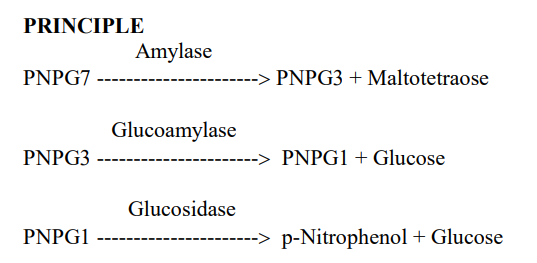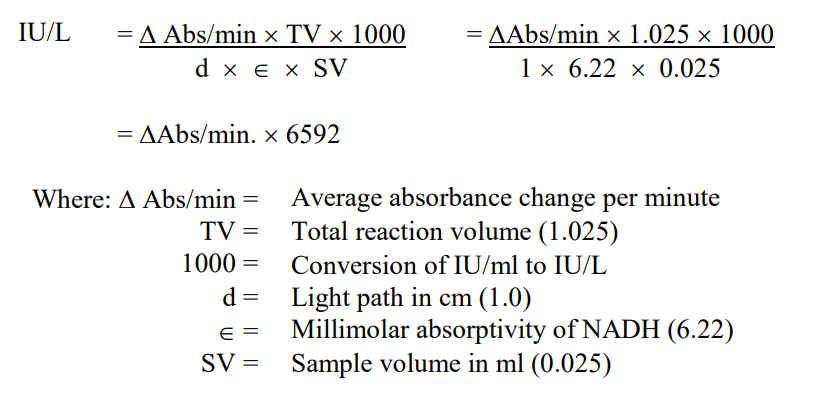CC2 LAB MIDTERMS FLASHCARDS
5.0(1)
Card Sorting
1/72
Earn XP
Study Analytics
Name | Mastery | Learn | Test | Matching | Spaced |
|---|
No study sessions yet.
73 Terms
1
New cards
Tissue Source/s of LDH
Heart, liver, muscle, kidney
2
New cards
Clinical Significance of LDH
↑ myocardial infarction, liver disease, renal disease, certain forms of anemia, malignant disease, progressive muscle dystrophy
3
New cards
Clinical significance of amylase
Diagnosis of acute pancreatitis
4
New cards
Clinical significance of lipase
Evaluate conditions associated with pancreas
5
New cards
LDH equation

6
New cards
Amylase equation

7
New cards
Lipase equation

8
New cards
Reagent stability for LDH
Reconstituted: 14 days (ref temp) 8 hours (room temp)
9
New cards
Reagent Composition LDH
• L-lactate (75mM)
• NAD (5.5 mM)
• Buffer (80 mM)
• pH 9.0
• Non-reactive stabilizers and fillers
• NAD (5.5 mM)
• Buffer (80 mM)
• pH 9.0
• Non-reactive stabilizers and fillers
10
New cards
Specimen Stability LDH
Serum: 2-3 days at room temp
11
New cards
Interfering Substances
oxalate
oxamate
EDTA
oxamate
EDTA
12
New cards
LDH: Reagent Volume
1ml
13
New cards
LDH: Pre-incubation (time and temp)
37°C for 3 minutes
14
New cards
LDH: Sample Volume
25uL
15
New cards
Wavelength LDH
340nm
16
New cards
Multiplier of LDH
6592
17
New cards
LDH: Time interval (reading)
2 minutes A1: read after 1 minute
18
New cards
LDH: expected values
Males
50-166 IU/L (30°C)
80-285 IU/L (37°C)
Females
60-132 IU/L (30°C)
103-227 IU/L (37°C)
50-166 IU/L (30°C)
80-285 IU/L (37°C)
Females
60-132 IU/L (30°C)
103-227 IU/L (37°C)
19
New cards
formula for LDH
△Abs/min × 6592
20
New cards
Limitations (LDH)
Samples with values above 800 IU/L should be diluted 1:1 with saline, re-assayed and the results multiplied by two (2).
21
New cards
Temperature Correction
1\. If the assay is performed at 37°C but is to be reported at 30°C; multiply the results by **0.6.**
2\. If the assay is performed at 30°C but is to be reported at 37°C; multiply the results by **1.7**
2\. If the assay is performed at 30°C but is to be reported at 37°C; multiply the results by **1.7**
22
New cards
LDH: procedure linearity
800 IU/L
23
New cards
millimolar absorptivity of NADH
6\.22
24
New cards
Formula to acquire multiplier in LDH

25
New cards
First quantitative method for Amylase assay
Iodemetric method
26
New cards
Who introduced iodometric method?
Wohlegemuth
27
New cards
Disadvantages of old methods in amylase assays
long incubation times
possible endogenous glucose interference
possible endogenous glucose interference
28
New cards
Who introduced the current method/assay used to quantify amylase?
Wallenfels
29
New cards
Substrate(s) in the method that Wallenfels introduced.
p-Nitrophenylglycosides or p-Nitrophenyl-D-Maltoheptaoside (PNPG7)
30
New cards
Lipase hydrolyzes _____?
glycerol esters of long-chain fatty acids
31
New cards
Advantage in the current method of amylase assay
short lag time
greater stability
greater stability
32
New cards
Final products of the reaction in amylase equation
p-Nitrophenol
Glucose
Glucose
33
New cards
What is measured in the LDH assay?
rate of formation of NADH
34
New cards
What color is produced when PNPG1 is hydrolyzed by glucosidase to glucose and p-Nitrophenol?
yellow
35
New cards
What are the three enzymes that are involved in the amylase assay?
amylase
glucoamylase
glucoasidase
glucoamylase
glucoasidase
36
New cards
Wavelength (Amylase)
405nm
37
New cards
Reagent stability (amylase)
Reconstituted:
10 days (room temp)
30 days (ref temp)
Unreconstituted:
until expiry (ref temp)
10 days (room temp)
30 days (ref temp)
Unreconstituted:
until expiry (ref temp)
38
New cards
Reagent Composition (Amylase)
• p-Nitrophenyl D-Malthoheptaoside 0.9 mM
• Glucosidase (yeast) (25, IU/L)
• Glucoamylase (Rhizopus Sp.) 10,000 IU/L
• Sodium chloride (50mM)
• Calcium chloride (5mM)
• Buffer (50mM)
• pH 6.9
• Glucosidase (yeast) (25, IU/L)
• Glucoamylase (Rhizopus Sp.) 10,000 IU/L
• Sodium chloride (50mM)
• Calcium chloride (5mM)
• Buffer (50mM)
• pH 6.9
39
New cards
specimen for amylase assay
serum and urine
40
New cards
Specimen Stability (amylase)
Serum & Urine:
1 week (room temp)
several months (ref temp)
\
Plasma: heparin tube
Urine: 24 hr period
1 week (room temp)
several months (ref temp)
\
Plasma: heparin tube
Urine: 24 hr period
41
New cards
Interfering Substances
Macroamylasemia ↑ pancreatic amylase in serum
Lipemia and hemolysis ↑ amylase
Insulin and some bacteria ↑ amylase
Lipemia and hemolysis ↑ amylase
Insulin and some bacteria ↑ amylase
42
New cards
Reagent Volume (amylase)
1ml
43
New cards
Pre-incubation (amylase)
37°C for 3 minutes
44
New cards
amylase: specimen volume
25uL
45
New cards
Multiplier (amylase)
4824
46
New cards
Millimolar absorptivity of p-Nitrophenol
8\.5
47
New cards
Time interval (reading)
Every 30 seconds for 2 minutes A1: read after 15 seconds
Note: 5 readings in total
Note: 5 readings in total
48
New cards
Expected Values Amylase
Serum: up to 96 IU/L Urine: 18 to 330 IU/L
49
New cards
formula for amylase assay
△Abs/min × 4824
50
New cards
amylase procedure limitations
Samples that exceeded the linearity limit (1,500 IU/L) should be diluted with an equal volume of saline and rerun. Multiply the result by two
51
New cards
To convert to nkat/L, the IU/L value should be multiplied to?
16\.67
52
New cards
Formula for corrected ΔAbs. /5min
Corrected ΔAbs. /5min = ΔAbs test- ΔAbs blank
53
New cards
why should hemolysis be avoided in LDH assay?
Erythrocytes release large amount of LDH (falsely elevated result)
54
New cards
he modified the method introduced by Voget
Shibabi
55
New cards
in the method proposed by Voget, what is measured in the assay?
rate of change in turbidity over a specific unit of time
56
New cards
Serum lipase hydrolyzes ____?
olive oil emulsion
57
New cards
TRUE OR FALSE. The increase in turbidity at 400nm is proportional to lipase activity in the specimen.
FALSE. (must be decrease in turbidity)
58
New cards
Reagent composition (lipase)
• Substrate: olive oil in alcohol
• Buffer: tris buffer (69mM), sodium deoxycholate (10mM), pH 9.0
• Buffer: tris buffer (69mM), sodium deoxycholate (10mM), pH 9.0
59
New cards
Reagent stability (lipase)
Reconstituted: 7 days (refrigerated)
Unreconstituted: until expiry (room temp)
Unreconstituted: until expiry (room temp)
60
New cards
In preparing the reagent for lipase assay, what volume of distilled water must be added?
25 ml
61
New cards
Specimen stability (lipase)
Serum:
1 week (room temp)
3 weeks (ref temp)
several months (frozen)
1 week (room temp)
3 weeks (ref temp)
several months (frozen)
62
New cards
Interfering substance (lipase)
Hemolyzed specimen
63
New cards
Reagent volume (lipase)
3 ml
64
New cards
Pre-incubation
37°C for 5 minutes
65
New cards
Sample volume (lipase)
100uL
66
New cards
Wavelength (lipase)
400nm
67
New cards
Multiplier (lipase)
1953
68
New cards
concentration of olive oil (micromoles/liter) in the working solution
315
69
New cards
Time interval (reading)
5 minutes after initial absorbance reading A1: read after adding sample and mixing (initial)
70
New cards
Expected values (lipase)
Adults: 10-150 U/L (age more than 60 years old 18-180 IU/L)
71
New cards
Procedure limitation (lipase)
Samples with values above 280 IU/L should be diluted 1:1 with distilled water, re-assayed and final results multiplied by two.
72
New cards
To convert IU/L to Cherry-Crandall units, divide IU/L by
70
73
New cards
One International Unit (IU) is defined as
the amount of enzyme that catalyzes the transformation of one micromole of substrate per minute under decreed conditions.